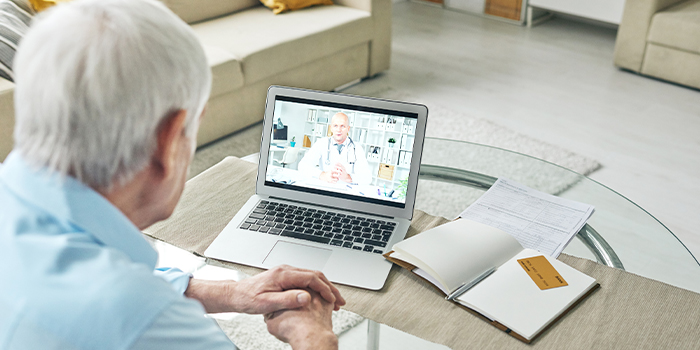1
2
3
4

In both name and practice, telemedicine combines advanced technology and medical practices to expand the reach of modern healthcare. It connects our short-term subacute rehab patients with their doctors and healthcare specialists in an instant, no matter how much distance is between them. That’s why we are proud to share how telemedicine technology assists our short-term rehabilitation patients.
Telemedicine has existed since the late 1950s, but it wasn’t accessible to the average person. Only recently has the healthcare industry seen new levels of implementation. Now, people consider telemedicine to be the next step in medical care.
Today, the technologies used in telemedicine are no longer a luxury. They’re easily implemented, simple to use, and as affordable as any other software-as-a-service solution. Telemedicine services, such as after-hours immediate care, family counseling, and video conferencing, have overcome traditional healthcare barriers and revolutionized the healthcare industry.
Taking Advantage of Telemedicine Technology
Technology has given people a taste for convenience that will not be shaken any time soon, and they demand the same flexibility from their healthcare providers. Telemedicine platforms allow staff to treat patients more effectively, reduce the need for emergency transports, and allow timely critical specialty consults. This improves the morale of patients, family, and staff.
About 90% of healthcare organizations in the U.S. are utilizing or implementing telemedicine to some degree, according to a Foley survey. Many people expect widespread adoption in the coming years as patients discover the telemedicine benefits through technology.
Here are three telemedicine benefits that patients who utilize its services can expect:
1. Improved Access to Quality Care and Services
In the past, if a skilled nursing patient’s status changed overnight, the on-call doctor and services would be notified. If care could not be assessed over the phone, then the patient was transported back to the hospital. This was stressful, time-consuming, and disruptive to his or her care plan.
Now, patients have improved access to their doctors and healthcare teams. Telemedicine provides the same level of care through an audio-visual platform, and it enables skilled nursing facility staff to contact skilled providers on demand. This means that we can proactively address noticeable changes and prevent care plan disruptions. Prior to the use of telemedicine technology, the problem could worsen while we waited two or three days for an appointment.
2. Reduced Healthcare Costs Overall
In a national study on the impacts of remote behavioral health interventions, researchers found that patient engagement in telemedicine services can improve the cost-efficiency of medical treatment for cardiac health patients. The cost savings were significant for both patients and their healthcare teams. Throughout the study, patients reported an average of 38% fewer hospital admissions, and they were much more engaged in their own healthcare in and out of the hospital.
Teleconferencing can also save outpatients the costs and hassle of physically visiting their providers, and it gives their healthcare teams instant visibility into their health statuses.
3. Improved Quality of Post-Hospital Care
Patients who experience life-threatening health events will require extensive care at a hospital followed by a skilled nursing inpatient rehabilitation stay. A telemedicine program can be used as an adjunct to care during the following weeks or months of rehab. It reduces stress on patients and families and improves clinical outcomes, making the addition of telemedicine to skilled nursing care a reassuring option.
When a patient’s subacute rehabilitation stay is complete and the patient returns to home, providers can check in with patients via phone or video in the time between appointments. Over 75% of patients say telemedicine follow-ups are more convenient than in-person visits. In cases like these, telemedicine aims to support, not replace, traditional healthcare.
At Marquis Health Services, our goal is to assist centers in providing patients and residents with information about access to instant care and help them avoid emergency room visits and hospitalization when possible. We realize the telemedicine benefits for patients, so we want to help create the best possible healthcare experiences.